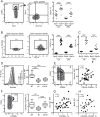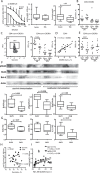Survivin co-ordinates formation of follicular T-cells acting in synergy with Bcl-6
- PMID: 26343374
- PMCID: PMC4652986
- DOI: 10.18632/oncotarget.4994
Survivin co-ordinates formation of follicular T-cells acting in synergy with Bcl-6
Abstract
Follicular T helper (Tfh) cells are recognized by the expression of CXCR5 and the transcriptional regulator Bcl-6. Tfh cells control B cell maturation and antibody production, and if deregulated, may lead to autoimmunity. Here, we study the role of the proto-oncogene survivin in the formation of Tfh cells. We show that blood Tfh cells of patients with the autoimmune condition rheumatoid arthritis, have intracellular expression of survivin. Survivin was co-localized with Bcl-6 in the nuclei of CXCR5+CD4 lymphocytes and was immunoprecipitated with the Bcl-6 responsive element of the target genes. Inhibition of survivin in arthritic mice led to the reduction of CXCR5+ Tfh cells and to low production of autoantibodies. Exposure to survivin activated STAT3 and induced enrichment of PD-1+Bcl-6+ subset within Tfh cells. Collectively, our study demonstrates that survivin belongs to the Tfh cell phenotype and ensures their optimal function by regulating transcriptional activity of Bcl-6.
Keywords: Bcl6; Immune response; Immunity; Immunology and Microbiology Section; T-cells; arthritis; autoimmunity; survivin.
Conflict of interest statement
The authors declare no conflict of interest.
Figures





Similar articles
-
Bcl6 middle domain repressor function is required for T follicular helper cell differentiation and utilizes the corepressor MTA3.Proc Natl Acad Sci U S A. 2015 Oct 27;112(43):13324-9. doi: 10.1073/pnas.1507312112. Epub 2015 Oct 12. Proc Natl Acad Sci U S A. 2015. PMID: 26460037 Free PMC article.
-
Di-(2-ethylhexyl) phthalate adjuvantly induces imbalanced humoral immunity in ovalbumin-sensitized BALB/c mice ascribing to T follicular helper cells hyperfunction.Toxicology. 2014 Oct 3;324:88-97. doi: 10.1016/j.tox.2014.07.011. Epub 2014 Aug 2. Toxicology. 2014. PMID: 25093321
-
PolyI:C and mouse survivin artificially embedding human 2B peptide induce a CD4+ T cell response to autologous survivin in HLA-A*2402 transgenic mice.Immunobiology. 2015 Jan;220(1):74-82. doi: 10.1016/j.imbio.2014.08.017. Epub 2014 Aug 23. Immunobiology. 2015. PMID: 25257859
-
Follicular Helper CD4+ T Cells in Human Neuroautoimmune Diseases and Their Animal Models.Mediators Inflamm. 2015;2015:638968. doi: 10.1155/2015/638968. Epub 2015 Aug 2. Mediators Inflamm. 2015. PMID: 26300592 Free PMC article. Review.
-
Tfh cell differentiation and their function in promoting B-cell responses.Adv Exp Med Biol. 2014;841:153-80. doi: 10.1007/978-94-017-9487-9_6. Adv Exp Med Biol. 2014. PMID: 25261207 Review.
Cited by
-
Dysregulation of Survivin-Targeting microRNAs in Autoimmune Diseases: New Perspectives for Novel Therapies.Front Immunol. 2022 Mar 3;13:839945. doi: 10.3389/fimmu.2022.839945. eCollection 2022. Front Immunol. 2022. Retraction in: Front Immunol. 2023 Sep 04;14:1285591. doi: 10.3389/fimmu.2023.1285591. PMID: 35309327 Free PMC article. Retracted. Review.
-
Survivin Measurement improves Clinical Prediction of Transition From Arthralgia to RA-Biomarkers to Improve Clinical Sensitivity of Transition From Arthralgia to RA.Front Med (Lausanne). 2018 Aug 2;5:219. doi: 10.3389/fmed.2018.00219. eCollection 2018. Front Med (Lausanne). 2018. PMID: 30116727 Free PMC article.
-
Anti-apoptotic Protein BIRC5 Maintains Survival of HIV-1-Infected CD4+ T Cells.Immunity. 2018 Jun 19;48(6):1183-1194.e5. doi: 10.1016/j.immuni.2018.04.004. Epub 2018 May 22. Immunity. 2018. PMID: 29802019 Free PMC article.
-
Long COVID manifests with T cell dysregulation, inflammation, and an uncoordinated adaptive immune response to SARS-CoV-2.bioRxiv [Preprint]. 2023 Aug 4:2023.02.09.527892. doi: 10.1101/2023.02.09.527892. bioRxiv. 2023. Update in: Nat Immunol. 2024 Feb;25(2):218-225. doi: 10.1038/s41590-023-01724-6. PMID: 36798286 Free PMC article. Updated. Preprint.
-
Simvastatin Inhibits Endotoxin-Induced Apoptosis in Liver and Spleen Through Up-Regulation of Survivin/NF-κB/p65 Expression.Front Pharmacol. 2019 Feb 15;10:54. doi: 10.3389/fphar.2019.00054. eCollection 2019. Front Pharmacol. 2019. PMID: 30828299 Free PMC article.
References
-
- Nutt SL, Tarlinton DM. Germinal center B and follicular helper T cells: siblings, cousins or just good friends? Nat Immunol. 2011;12:472–7. - PubMed
-
- Ma CS, Deenick EK. Human T follicular helper (Tfh) cells and disease. Immunol Cell Biol. 2014;92:64–71. - PubMed
-
- Tangye SG, Cook MC, Fulcher DA. Insights into the role of STAT3 in human lymphocyte differentiation as revealed by the hyper-IgE syndrome. J Immunol. 2009;182:21–8. - PubMed
-
- Crotty S. Follicular helper CD4 T cells (TFH) Annu Rev Immunol. 2011:29621–63. - PubMed
Publication types
MeSH terms
Substances
LinkOut - more resources
Full Text Sources
Other Literature Sources
Research Materials
Miscellaneous

